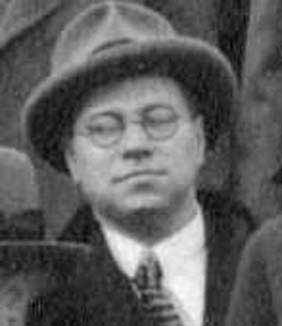


 تاريخ الرياضيات
تاريخ الرياضيات
 الرياضيات في الحضارات المختلفة
الرياضيات في الحضارات المختلفة 
 الرياضيات المتقطعة
الرياضيات المتقطعة
 الجبر
الجبر
 الهندسة
الهندسة 
 المعادلات التفاضلية و التكاملية
المعادلات التفاضلية و التكاملية 
 التحليل
التحليل
 علماء الرياضيات
علماء الرياضيات |
Read More
Date: 29-8-2017
Date: 20-8-2017
Date: 20-8-2017
|
Died: 7 April 1934 in Münster, Germany

Heinz Prüfer was born in Wilhelmshaven, a city and port situated on a North Sea inlet. His father had an engineering background and worked for the Imperial Navy as a technical secretary but later worked for the Department of Transportation.
Prüfer studied at the University of Berlin where he was taught by Frobenius in the year before his death. He was also taught by Schur who had returned to the University of Berlin in 1916 after holding a professorship in Bonn. It was Schur's mathematics which attracted Prüfer most, and after completing his first degree he undertook research for his doctorate under Schur's supervision. This was an exciting time for algebraists at the University of Berlin for Schur was gathering a group of talented young people around him. During the time that Prüfer worked with Schur, students such as Alfred Brauer and his brother Richard Brauer attended Schur's seminar. Schur held weekly problem hours, and in these sessions he would give the students difficult problems most of which he had solved, but occasionally he gave the class an open problem which he did not know how to solve.
Prüfer wrote his doctoral thesis on abelian groups, the topic for which he is best remembered today. His thesis entitled Unendliche Abelsche Gruppen von Elementen endlicher Ordnung (Infinite abelian groups of elements of finite order) was submitted to the University of Berlin in 1921 and after he was examined by Schur and Schmidt he was awarded the degree on 13 October of that year. It is worth noting that the results that Prüfer proved in this work are all stated in terms of countable groups although they hold for groups of arbitrary cardinality. The reason for restricting the results in that way was that cardinals greater than countable were not accepted by all mathematicians at that time.
After the award of his doctorate, Prüfer was appointed as an assistant in Hamburg. After three years he moved to a second assistantship, this time in Jena. In October 1927 he became a dozent at the University of Münster, holding this post until his early death from lung cancer at the age of 37. Mader writes in [1]:-
Heinz Prüfer was a shy but independent person, and not easy to approach. He was a dedicated and serious teacher and in all his work extremely careful - a trait that his dissertation demonstrates convincingly with its even and impeccable script. In spite of his youth he was quite bald, chubby and wearing a beard, not exactly handsome in appearance. He left a wife when he died but had no children.
Prüfer was an algebraist whose name is familiar to many people even though his bibliography comprises only ten items, four of which are concerned with the structure of abelian groups. In 1923 he published Untersuchungen über die Zerlegbarkeit der abzählbaren primären Abelschen Gruppen which investigates the decomposability of countable primary abelian groups. This paper introduces the concepts of height and purity, and investigates how far the basis theorem for finite abelian groups generalises to countable p-groups. It also contains the 'Theorem of Prüfer':
Every countable p-group is the direct sum of rank 1 groups if and only if every element of infinite height is contained in a subgroup of type p∞.
The 'Prüfer group' Z(p∞) shows that there exist countable p-groups that are not the direct sum of rank 1 groups.
In his next major contribution to abelian groups Prüfer published a two part paper Theorie der Abelschen Gruppen. The first part appeared in 1924 and the second in the following year. In this paper Prüfer stresses that all the results hold for modules over a principal ideal domain. The 'Prüfer topology' in introduced in the second paper as is a concept which Lefschetz called 'linearly compact groups' in a paper he published in 1942. Prüfer gives a decomposition theorem for 'linearly compact groups' and shows that those of finite rank are the direct product of rank 1 groups.
In addition to his work on abelian groups, Prüfer also worked on algebraic numbers, publishing the paper Neue Begründung der algebraischen Zahlentheorie in 1925, and knot theory. His lecture notes on knot theory were published in 1933. He also published a paper on Sturm-Liouville theory; Neue Herleitung der Sturm-Liouvilleschen Reihenentwicklung stetiger Funktionen (1926). After his death his lectures notes on projective geometry were collected and published as the 314 page book Projektive Geometrie (1933). A second edition of the book was published in 1953.
Articles:



|
|
|
|
دخلت غرفة فنسيت ماذا تريد من داخلها.. خبير يفسر الحالة
|
|
|
|
|
|
|
ثورة طبية.. ابتكار أصغر جهاز لتنظيم ضربات القلب في العالم
|
|
|
|
|
|
|
العتبة العبّاسية المقدّسة تدعو جامعة واسط للمشاركة في الحفل المركزيّ لتخرّج طلبة الجامعات
|
|
|